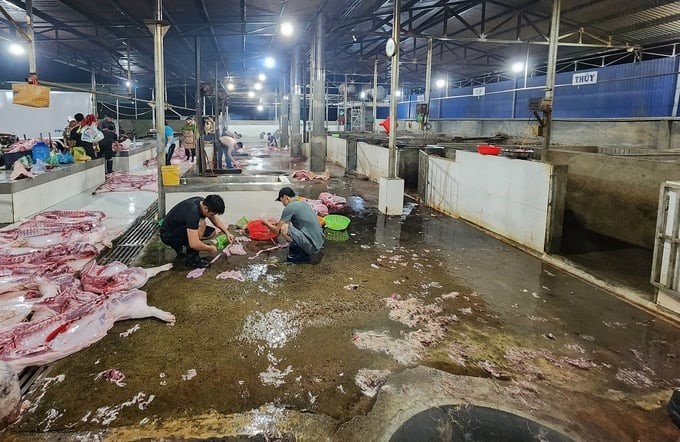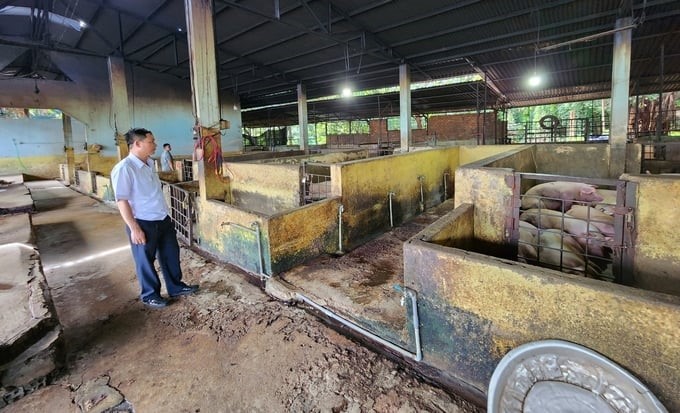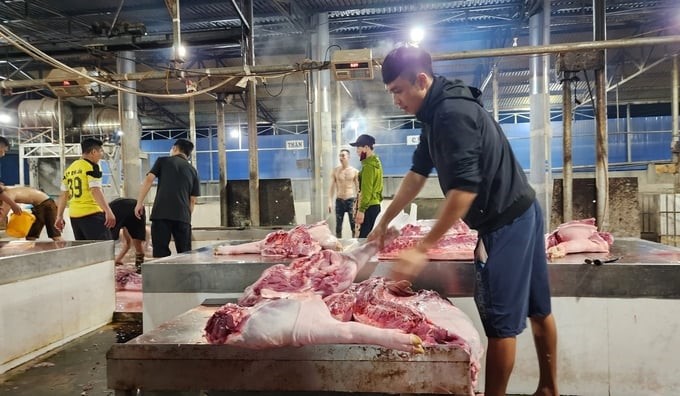May 24, 2025 | 16:20 GMT +7
May 24, 2025 | 16:20 GMT +7
Hotline: 0913.378.918
May 24, 2025 | 16:20 GMT +7
Hotline: 0913.378.918

The Dak Lak Animal Husbandry and Veterinary Sub-Department has strengthened inspection of slaughterhouses to ensure compliance with provisions. Photo: Minh Quy.
According to the Dak Lak Animal Husbandry and Veterinary Sub-Department, in 2022, this unit appraised and certified animal slaughterhouses of food safety eligibility for 26 concentrated slaughter facilities in 10 districts, Buon Ho town, and Buon Ma Thuot city.
The Sub-Department inspected 9 concentrated animal slaughter facilities and granted 6 certificates of food safety eligibility for facilities achieving grades A and B. The inspection delegation also issued a document to temporarily suspend operations at 3 slaughterhouses, not ensuring operating conditions.
Mr. Mai Xuan Ly, Deputy Director of the Dak Lak Animal Husbandry and Veterinary Sub-Department, said that in addition to appraising and certifying animal slaughterhouses, the unit has established an inspection team to check compliance with provisions of the law on food safety and veterinary hygiene for slaughter and business facilities of animals and animal products in the area.
Most concentrated animal slaughter facilities have been built since the 2000s and are now located in residential areas, near schools, or near markets. Facilities have been operating for a long time but are not regularly maintained and repaired, so they are degraded and pollute the environment.
"The planning and management of livestock and poultry slaughter and pre-processing and trading activities of animal products now still has many shortcomings and lacks synchronization of branches. Specifically, relocating slaughterhouses located in residential areas and planning land locations that meet conditions for building a modern, large-scale concentrated slaughter facilities have not received attention.
In some districts and communes, there are no concentrated slaughter facilities; the slaughter mainly takes place at small animal slaughterhouses, causing slaughter control to not really ensure food safety. Slaughter activities still take place spontaneously, with many small animal slaughterhouses, while local authorities do not pay attention to or manage them but mainly assign the local veterinary force to take charge of slaughter control. Therefore, it is difficult to control," said Mr. Ly.

Slaughter facilities wish to move out of residential areas but do not have a land fund. Photo: Minh Quy.
According to Mr. Ly, the current inspection and issuance of veterinary hygiene and food safety certificates still have many overlaps in documents, without specific instructions or adjustments when new related legal documents are issued.
Therefore, local authorities need to pay more attention to the planning and management of livestock and poultry slaughter and pre-processing and trading activities of animal products; have mechanisms and policies to relocate slaughterhouses located in residential areas; and plan land positions that meet conditions for building a modern, large-scale concentrated animal slaughterhouse.
“Currently, the system of livestock and veterinary officers at the grassroots level is an important force in deploying and implementing slaughter control at the facility. Therefore, it is recommended that the Central continue to pay attention to, create conditions for, and support the system of livestock and veterinary staff at the grassroots level in training and coaching to improve the capacity to perform professional work and enjoy health insurance. It is also necessary to increase the allowance level to help grass-roots animal husbandry and veterinary staff improve their lives, feel secure in their work, strive, and make efforts to always complete their tasks well," Mr. Ly proposed.
In order for the local livestock and slaughter industry to develop, the Dak Lak Provincial People's Committee has issued a Directive on strengthening the management and control of animal slaughter to ensure disease safety and food safety.
In particular, the Dak Lak Provincial People's Committee clearly directed the People's Committees of districts, towns, and the city to implement the planning and supplement land funds to build concentrated animal slaughter facilities in the area according to the Decision of the Provincial People's Committee on approval of the livestock development strategy in Dak Lak province for the period 2021–2030 with a vision to 2045.
Specifically, for slaughtering and processing livestock products, localities strive to ensure that by 2030, each district, town, and city will have at least one concentrated slaughter facility, and the province will have a livestock product processing factory.

Dak Lak aims to have at least one concentrated slaughter facility by 2030. Photo: Minh Quy.
With a vision to 2045, Dak Lak strives to ensure that 100% of livestock and poultry meat products will be supplied from centralized, industrial slaughterhouses, and over 70% of the volume of main livestock products will be pre-processed and processed industrially, of which about 10% is deeply processed.
Mr. Vu Duc Con, Deputy Director of the Dak Lak Department of Agriculture and Rural Development, said that to do this, the province will reorganize the livestock and poultry slaughter and processing system in a centralized and industrial manner to ensure requirements for veterinary hygiene, food safety, environmental protection, and humane treatment of pets.
This locality believes that, along with policies to encourage the development of centralized and industrial slaughter activities, it is necessary to strengthen management measures for the slaughter work, especially small and manual slaughter facilities that do not ensure veterinary hygiene and food safety.
“The Provincial People's Committee assigned the Department of Agriculture and Rural Development to host and coordinate with related departments, branches, and localities to implement the livestock development strategy in Dak Lak province in the period 2021–2030, with a vision to 2045. In addition, the Department also needs to inspect, supervise, preliminarily review, and evaluate annual and 5-year implementation results, and recommend and propose to authorities to resolve arising issues in accordance with the strategy and actual situation of the local economy.
When implementing, the Department will encourage the development of the processing industry and deep processing of livestock products to diversify and enhance the value of livestock products in accordance with the needs of consumption markets inside and outside the province and export," Mr. Con emphasized.
Translated by Huyen Vu Thu

(VAN) The People's Committee of Tra Vinh province has approved an adjustment to the investment policy for the Green Hydrogen Plant project, increasing its area to approximately 52.76 hectares.
![Reducing emissions from rice fields: [2] Farmers’ commitment to the soil](https://t.ex-cdn.com/nongnghiepmoitruong.vn/608w/files/news/2025/05/05/dsc08881jpg-nongnghiep-140632.jpg)
(VAN) Clean rice cultivation model in Thuong Tan commune, Bac Tan Uyen district, is assisting local residents in achieving sustainable agriculture by substantially reducing costs, increasing productivity, and protecting the environment.

(VAN) At the conference to disseminate Resolution No. 68, AgriS introduced its digital agricultural ecosystem and reaffirmed its commitment to accompanying the Government in promoting private sector development and sustainable agriculture.

(VAN) 'Blue Ocean - Blue Foods' initiative is designed to restore marine ecosystems and establish sustainable livelihoods for local communities by cultivating a minimum of 1,000 hectares of cottonii seaweed in the first three years.
/2025/05/21/4642-3-112707_603.jpg)
(VAN) The V-SCOPE project has made direct contributions to three out of six pillars of the Comprehensive Strategic Partnership between Vietnam and Australia.

(VAN) Facing the threat of rabies spreading to the community, Gia Lai province urgently carries out measures to vaccinate dogs and cats on a large scale.

(VAN) Disease-free livestock farming not only protects livestock herds but also stabilizes production and livelihoods for many farmers in Tuyen Quang.